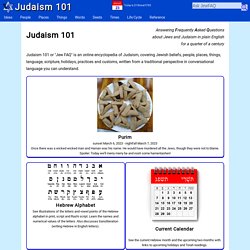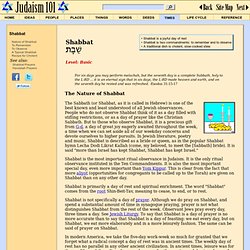

Judaism 101. Judaism 101 is an online encyclopedia of Judaism, covering Jewish beliefs, people, places, things, language, scripture, holidays, practices and customs.

My goal is to make freely available a wide variety of basic, general information about Judaism, written from a traditional perspective in plain English. This web site has grown continually for more than 10 years and continues to be updated periodically. The information in this site is written predominantly from the Orthodox viewpoint, because I believe that is a good starting point for any inquiry into Judaism. As recently as 300 years ago, this was the only Judaism, and it still is the only Judaism in many parts of the world. Be aware, however, that many Jews do not follow all of the traditions described here, or do not follow them in the precise form described here. Where to Start There are over eighty web pages on this site, comprising over 300 pages of text, a virtual book of information on Judaism. Just browsing? Hebrew Alphabet. The Hebrew and Yiddish languages use a different alphabet than English.

The picture below illustrates the Hebrew alphabet, in Hebrew alphabetical order. Note that Hebrew is written from right to left, rather than left to right as in English, so Alef is the first letter of the Hebrew alphabet and Tav is the last. The Hebrew alphabet is often called the "alefbet," because of its first two letters. Letters of the Alefbet Table 1: The Hebrew Alphabet If this sounds like Greek to you, you're not far off!
The "Kh" and the "Ch" are pronounced as in German or Scottish, a throat clearing noise, not as the "ch" in "chair. " Note that there are two versions of some letters. Vowels and Points Like most early Semitic alphabetic writing systems, the alefbet has no vowels. However, as Hebrew literacy declined, particularly after the Romans expelled the Jews from Israel, the rabbis recognized the need for aids to pronunciation, so they developed a system of dots and dashes called nikkud (points). Shabbat. For six days you may perform melachah, but the seventh day is a complete Sabbath, holy to the L-RD ... it is an eternal sign that in six days, the L-RD made heaven and earth, and on the seventh day he rested and was refreshed.

-Exodus 31:15-17 The Nature of Shabbat The Sabbath (or Shabbat, as it is called in Hebrew) is one of the best known and least understood of all Jewish observances. People who do not observe Shabbat think of it as a day filled with stifling restrictions, or as a day of prayer like the Christian Sabbath. But to those who observe Shabbat, it is a precious gift from G-d, a day of great joy eagerly awaited throughout the week, a time when we can set aside all of our weekday concerns and devote ourselves to higher pursuits. Shabbat is the most important ritual observance in Judaism.
Shabbat is primarily a day of rest and spiritual enrichment. Shabbat is not specifically a day of prayer. Zakhor: To Remember What does the Exodus have to do with resting on the seventh day?